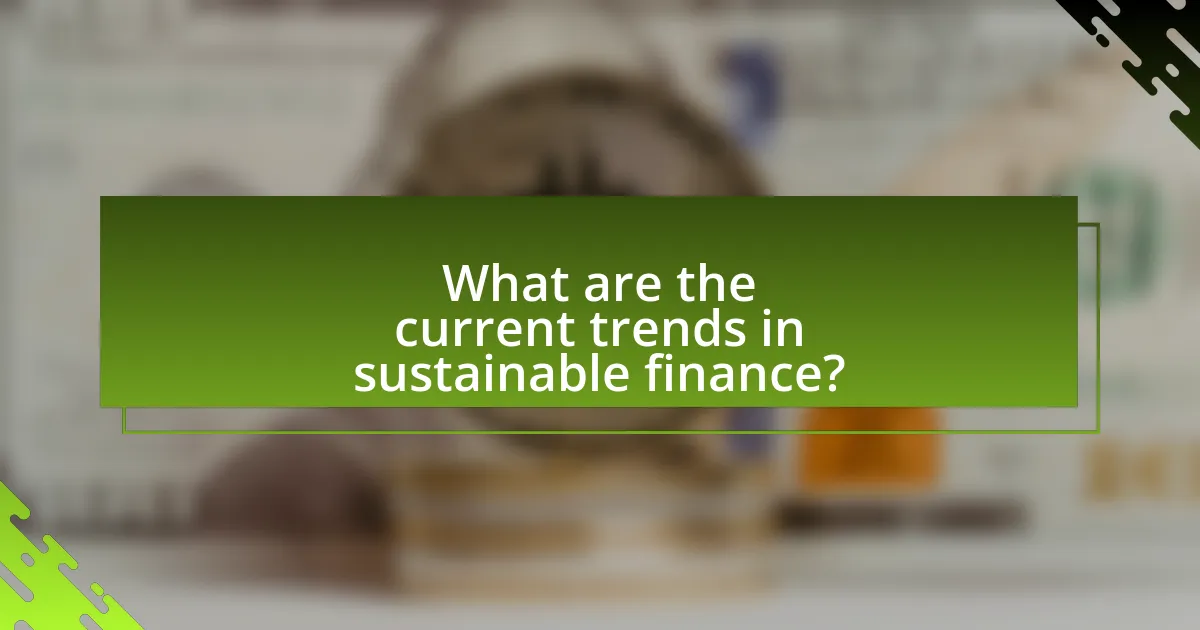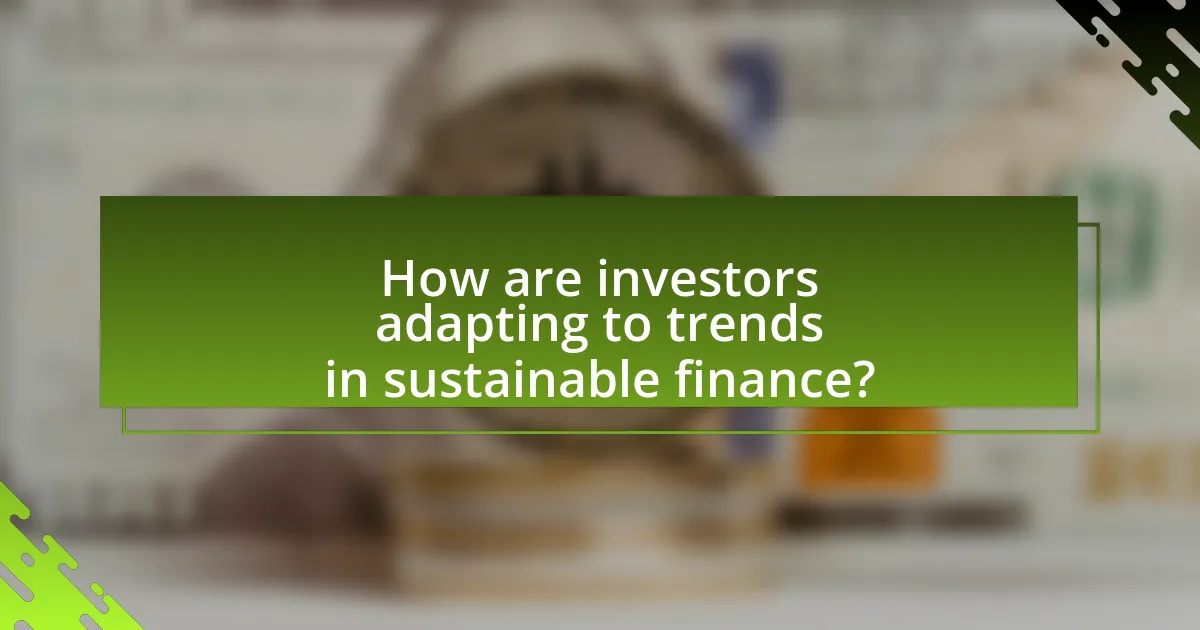The article focuses on current trends in sustainable finance, emphasizing the integration of Environmental, Social, and Governance (ESG) criteria into investment decisions, the rise of green bonds, and the increasing demand for sustainable investment products. It highlights the significant growth of the sustainable investment market, which reached approximately $35 trillion in assets under management in 2020, and discusses the evolving regulatory frameworks aimed at enhancing transparency in sustainable investments. Key principles of sustainable finance, the impact of ESG factors on investment decisions, and the challenges investors face in this sector are also examined, along with strategies for incorporating sustainability into investment portfolios. Additionally, the article explores the role of technology and regulatory changes in shaping the future of sustainable finance.

What are the current trends in sustainable finance?
Current trends in sustainable finance include the increasing integration of Environmental, Social, and Governance (ESG) criteria into investment decisions, the rise of green bonds, and the growing demand for sustainable investment products. The global sustainable investment market reached approximately $35 trillion in assets under management in 2020, reflecting a 15% increase from 2018, according to the Global Sustainable Investment Alliance. Additionally, regulatory frameworks are evolving, with initiatives like the EU Sustainable Finance Disclosure Regulation aiming to enhance transparency and accountability in sustainable investments.
How is sustainable finance defined in today’s context?
Sustainable finance is defined today as financial activities that incorporate environmental, social, and governance (ESG) criteria into investment decisions and risk management processes. This definition reflects a growing recognition among investors and financial institutions of the importance of sustainability in achieving long-term financial performance and mitigating risks associated with climate change and social inequality. According to the Global Sustainable Investment Alliance, sustainable investment assets reached $35.3 trillion in 2020, indicating a significant shift towards integrating sustainability into the financial sector.
What are the key principles of sustainable finance?
The key principles of sustainable finance include the integration of environmental, social, and governance (ESG) factors into financial decision-making. This approach aims to promote long-term value creation while addressing global challenges such as climate change and social inequality. Evidence shows that companies with strong ESG practices tend to outperform their peers financially, as reported by the Global Sustainable Investment Alliance, which indicated that global sustainable investment reached $35.3 trillion in 2020, reflecting a growing recognition of the importance of sustainability in finance.
How has the definition of sustainable finance evolved over time?
The definition of sustainable finance has evolved from a focus on environmental considerations to a broader integration of social and governance factors alongside environmental issues. Initially, sustainable finance primarily emphasized environmental sustainability, particularly in response to climate change and resource depletion. Over time, the definition expanded to include social equity and governance practices, reflecting a more holistic approach to sustainability. This shift is evidenced by the adoption of frameworks such as the United Nations Sustainable Development Goals (SDGs) in 2015, which encouraged investors to consider a wider range of impacts, including social justice and corporate governance, in their financial decisions.
Why is sustainable finance gaining importance among investors?
Sustainable finance is gaining importance among investors due to the increasing recognition of environmental, social, and governance (ESG) factors as critical components of long-term financial performance. Investors are increasingly aware that companies with strong ESG practices tend to exhibit lower risk profiles and better resilience during economic downturns. For instance, a study by MSCI found that companies with high ESG ratings outperformed their lower-rated counterparts during market volatility, demonstrating that sustainable practices can lead to enhanced financial returns. Additionally, regulatory pressures and consumer demand for responsible investment options are driving investors to prioritize sustainability in their portfolios.
What are the driving factors behind the rise of sustainable finance?
The driving factors behind the rise of sustainable finance include increasing awareness of climate change, regulatory pressures, and shifting investor preferences. Climate change awareness has led to a demand for investments that contribute to environmental sustainability, with studies indicating that 70% of investors consider sustainability in their investment decisions. Regulatory pressures, such as the European Union’s Sustainable Finance Disclosure Regulation, require financial institutions to disclose sustainability risks, further promoting sustainable investment practices. Additionally, a growing number of investors, particularly millennials, prioritize ethical and sustainable investments, driving the market towards more responsible finance options.
How does sustainable finance impact investment decisions?
Sustainable finance significantly impacts investment decisions by prioritizing environmental, social, and governance (ESG) criteria in the evaluation of potential investments. Investors increasingly consider ESG factors as they correlate with long-term financial performance; for instance, a study by the Global Sustainable Investment Alliance reported that sustainable investment assets reached $35.3 trillion in 2020, reflecting a 15% increase over two years. This trend indicates that investors are not only seeking financial returns but also aiming to align their portfolios with sustainable practices, which can mitigate risks associated with climate change and social inequality. Consequently, companies that demonstrate strong ESG performance are often viewed as more attractive investment opportunities, influencing capital allocation towards sustainable projects and businesses.
What are the major types of sustainable finance instruments?
The major types of sustainable finance instruments include green bonds, social bonds, sustainability bonds, and impact investing funds. Green bonds are specifically designed to finance projects that have positive environmental impacts, such as renewable energy or energy efficiency initiatives. Social bonds focus on funding projects that address social issues, such as affordable housing or education. Sustainability bonds combine both environmental and social benefits, financing projects that meet both criteria. Impact investing funds aim to generate measurable social and environmental impact alongside a financial return, often targeting specific sectors like clean technology or sustainable agriculture. These instruments are increasingly recognized for their role in mobilizing capital towards sustainable development goals, as evidenced by the growth of the green bond market, which reached over $1 trillion in issuance by 2021.
What are green bonds and how do they function?
Green bonds are fixed-income financial instruments specifically earmarked to raise funds for projects with positive environmental impacts. These bonds function by allowing issuers, such as governments or corporations, to borrow money from investors, promising to pay back the principal along with interest over a specified period. The proceeds from green bonds are exclusively used to finance or refinance projects that contribute to sustainability, such as renewable energy, energy efficiency, and pollution prevention. According to the Climate Bonds Initiative, the global green bond market reached over $1 trillion in issuance by 2021, demonstrating significant investor interest and commitment to financing environmentally beneficial projects.
What role do ESG (Environmental, Social, and Governance) criteria play in sustainable finance?
ESG (Environmental, Social, and Governance) criteria play a crucial role in sustainable finance by guiding investment decisions towards companies that prioritize sustainability and ethical practices. These criteria help investors assess the long-term viability and risk of their investments, as companies with strong ESG performance are often more resilient to market fluctuations and regulatory changes. For instance, a study by MSCI found that companies with high ESG ratings tend to have lower capital costs and better operational performance, indicating that integrating ESG factors can lead to superior financial returns. Thus, ESG criteria not only align investments with ethical values but also enhance financial performance and risk management in sustainable finance.

How are investors adapting to trends in sustainable finance?
Investors are adapting to trends in sustainable finance by integrating environmental, social, and governance (ESG) criteria into their investment strategies. This shift is evidenced by a significant increase in sustainable investment assets, which reached $35.3 trillion globally in 2020, representing a 15% increase from 2018, according to the Global Sustainable Investment Alliance. Additionally, investors are increasingly engaging with companies to promote sustainable practices, as seen in the rise of shareholder resolutions focused on climate change and social responsibility. This proactive approach reflects a growing recognition that sustainable investments can yield competitive financial returns while addressing global challenges.
What strategies are investors using to incorporate sustainability into their portfolios?
Investors are increasingly using strategies such as ESG integration, impact investing, and sustainable thematic investing to incorporate sustainability into their portfolios. ESG integration involves evaluating environmental, social, and governance factors alongside traditional financial metrics to inform investment decisions. For instance, a 2021 report by the Global Sustainable Investment Alliance indicated that global sustainable investment reached $35.3 trillion, reflecting a growing trend among investors to prioritize ESG criteria.
Impact investing focuses on generating measurable social and environmental benefits alongside financial returns, with investors actively seeking opportunities that address issues like climate change and social inequality. According to the Global Impact Investing Network, the impact investing market was valued at $715 billion in 2020, showcasing its significance in sustainable finance.
Sustainable thematic investing targets specific sectors or themes, such as renewable energy or sustainable agriculture, allowing investors to align their portfolios with their values. The International Energy Agency reported that investments in renewable energy reached $303.5 billion in 2020, highlighting the financial viability of such themes. These strategies collectively demonstrate how investors are actively reshaping their portfolios to reflect sustainability goals.
How do investors assess the sustainability of potential investments?
Investors assess the sustainability of potential investments by evaluating Environmental, Social, and Governance (ESG) criteria. These criteria provide a framework for measuring the sustainability and ethical impact of an investment. For instance, investors analyze a company’s carbon footprint, labor practices, and board diversity to determine its overall sustainability performance. Research indicates that companies with strong ESG practices often demonstrate better financial performance and lower risk, as highlighted in a study by the Morgan Stanley Institute for Sustainable Investing, which found that sustainable equity funds outperformed traditional funds by 4.3% in 2020. This evidence supports the notion that incorporating sustainability assessments can lead to more informed investment decisions.
What tools and resources are available for investors focusing on sustainable finance?
Investors focusing on sustainable finance have access to various tools and resources, including ESG (Environmental, Social, and Governance) rating agencies, sustainable investment platforms, and financial data analytics tools. ESG rating agencies, such as MSCI and Sustainalytics, provide assessments of companies based on their sustainability practices, helping investors make informed decisions. Sustainable investment platforms like BlackRock’s Aladdin and Morningstar’s Sustainalytics offer comprehensive data and analytics on sustainable investment options. Additionally, financial data analytics tools, such as Bloomberg Terminal, provide real-time data on sustainable investments, enabling investors to track performance and trends effectively. These resources collectively enhance the ability of investors to align their portfolios with sustainable finance principles.
What challenges do investors face in sustainable finance?
Investors face several challenges in sustainable finance, primarily including a lack of standardized metrics for measuring sustainability, limited access to reliable data, and the potential for greenwashing. The absence of universally accepted frameworks makes it difficult for investors to assess the true sustainability of investments. For instance, a 2021 report by the Global Sustainable Investment Alliance indicated that only 30% of sustainable investment products adhere to recognized standards, complicating investment decisions. Additionally, many companies may exaggerate their sustainability efforts, leading to greenwashing, which misleads investors about the environmental impact of their investments. These challenges hinder effective decision-making and risk assessment in sustainable finance.
How can investors overcome the barriers to sustainable investing?
Investors can overcome the barriers to sustainable investing by increasing their knowledge and understanding of sustainable finance, utilizing available tools and resources, and engaging with stakeholders. Education on sustainable investment strategies and the benefits of ESG (Environmental, Social, and Governance) factors can empower investors to make informed decisions. For instance, a report by the Global Sustainable Investment Alliance indicates that sustainable investment assets reached $35.3 trillion in 2020, highlighting the growing market and potential returns. Additionally, leveraging platforms that provide ESG data and analytics can help investors assess risks and opportunities effectively. Engaging with companies on sustainability issues fosters transparency and accountability, further enabling informed investment choices.
What are the risks associated with sustainable finance investments?
Sustainable finance investments carry several risks, including regulatory risk, market risk, and reputational risk. Regulatory risk arises from changing government policies and regulations that may impact the viability of sustainable projects; for instance, the European Union’s Green Deal may impose stricter guidelines that could affect investment returns. Market risk is associated with the volatility of sustainable assets, which can be influenced by shifts in investor sentiment or economic conditions; a report from the Global Sustainable Investment Alliance indicates that sustainable investments can experience fluctuations similar to traditional investments. Reputational risk stems from the potential backlash against companies that fail to meet sustainability claims or standards, as seen in cases where firms faced public scrutiny for greenwashing. These risks highlight the complexities investors must navigate in the sustainable finance landscape.

What future trends should investors watch in sustainable finance?
Investors should watch the increasing integration of Environmental, Social, and Governance (ESG) criteria into investment strategies as a key trend in sustainable finance. This shift is driven by growing consumer demand for responsible investing, with a 2021 report from the Global Sustainable Investment Alliance indicating that global sustainable investment reached $35.3 trillion, a 15% increase from 2018. Additionally, regulatory frameworks are evolving, with the European Union’s Sustainable Finance Disclosure Regulation (SFDR) requiring financial market participants to disclose sustainability risks, further pushing the market towards transparency and accountability. These trends indicate a significant movement towards sustainable finance that investors cannot afford to overlook.
How is technology influencing sustainable finance?
Technology is significantly influencing sustainable finance by enhancing data analytics, improving transparency, and facilitating access to sustainable investment opportunities. Advanced technologies such as artificial intelligence and blockchain enable investors to analyze vast amounts of environmental, social, and governance (ESG) data more efficiently, leading to informed decision-making. For instance, a report by the Global Sustainable Investment Alliance indicates that the integration of technology in finance has led to a 34% increase in sustainable investment assets globally from 2016 to 2018, demonstrating the growing impact of tech-driven solutions in this sector. Additionally, blockchain technology enhances transparency in transactions, allowing for better tracking of sustainable practices and compliance, which builds investor trust and encourages more capital flow into sustainable projects.
What role do fintech innovations play in promoting sustainable finance?
Fintech innovations play a crucial role in promoting sustainable finance by enhancing access to financial services and enabling more efficient allocation of capital towards environmentally and socially responsible projects. These technologies, such as blockchain and artificial intelligence, facilitate transparent tracking of investments, allowing investors to assess the sustainability impact of their portfolios. For instance, a report by the World Economic Forum highlights that fintech can streamline the process of issuing green bonds, making it easier for companies to raise funds for sustainable initiatives. Additionally, fintech platforms often provide data analytics that help investors identify and evaluate sustainable investment opportunities, thereby driving capital towards projects that align with sustainability goals.
How can data analytics enhance sustainable investment strategies?
Data analytics can enhance sustainable investment strategies by providing actionable insights through the analysis of large datasets related to environmental, social, and governance (ESG) factors. By leveraging advanced analytics, investors can identify trends, assess risks, and evaluate the impact of their investments on sustainability metrics. For instance, a study by MSCI found that companies with high ESG ratings tend to have lower capital costs and better operational performance, indicating that data-driven insights can lead to more informed investment decisions that align with sustainability goals.
What regulatory changes are expected in sustainable finance?
Regulatory changes expected in sustainable finance include the implementation of stricter disclosure requirements for companies regarding their environmental, social, and governance (ESG) practices. The European Union’s Sustainable Finance Disclosure Regulation (SFDR), effective since March 2021, mandates that financial market participants disclose how they integrate sustainability risks into their investment decisions. Additionally, the International Financial Reporting Standards (IFRS) Foundation is working on establishing a global sustainability reporting framework, which aims to standardize ESG disclosures across jurisdictions. These changes are driven by the increasing demand for transparency and accountability in sustainable investments, as evidenced by a 2021 report from the Global Sustainable Investment Alliance, which indicated that global sustainable investment reached $35.3 trillion, a 15% increase from 2018.
How might global policies impact sustainable finance trends?
Global policies significantly influence sustainable finance trends by establishing regulatory frameworks that promote environmental, social, and governance (ESG) criteria. For instance, the European Union’s Sustainable Finance Disclosure Regulation mandates financial institutions to disclose how they integrate sustainability risks, thereby driving investment towards greener projects. This regulatory push has led to a marked increase in green bonds issuance, which reached $269.5 billion in 2020, reflecting a growing alignment of capital flows with sustainability goals. Additionally, international agreements like the Paris Agreement create a global standard for emissions reductions, compelling countries to adopt policies that incentivize sustainable investments. Such policies not only shape market expectations but also enhance the credibility and attractiveness of sustainable finance, ultimately steering capital towards more sustainable economic activities.
What are the implications of increased transparency and reporting requirements?
Increased transparency and reporting requirements enhance accountability and trust among stakeholders in sustainable finance. These implications lead to improved decision-making by investors, as they gain access to more reliable data regarding environmental, social, and governance (ESG) factors. For instance, a study by the Global Reporting Initiative found that companies with higher transparency levels tend to attract more investment, as investors prioritize firms that demonstrate commitment to sustainability. Furthermore, enhanced reporting can drive companies to adopt better practices, ultimately contributing to long-term financial performance and risk management.
What practical steps can investors take to engage with sustainable finance?
Investors can engage with sustainable finance by integrating environmental, social, and governance (ESG) criteria into their investment decisions. This involves assessing potential investments based on their sustainability practices, such as carbon footprint, labor practices, and board diversity. According to the Global Sustainable Investment Alliance, sustainable investment assets reached $35.3 trillion in 2020, reflecting a growing trend among investors to prioritize sustainability. Additionally, investors can participate in shareholder advocacy, pushing companies to adopt more sustainable practices, and can allocate funds to green bonds or sustainable mutual funds, which specifically finance environmentally friendly projects.



